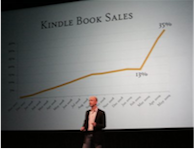I love my Kindle. I know that Richard Stallman calls it a swindle and abhors the DRM that makes it what it is. For me what it is a lightweight, reading platform with a battery that I never worry about charging, text that adjusts to my failing eyesight and a library in my suit pocket. I love that I can sample materials from the amazon store before I buy and that my library can be deployed across a series of linked devices. The cloud tracks my progress and keeps me synced and the whims of my personal reading preferences are catered for. All that said I love browsing at Hodges and Figgis and Dubray. I find many of the books I want to read in piles and on shelves in the stores. I want the showroom to get their brokerage cut. This doesn’t happen today and I want to figure out how it can.
calls it a swindle and abhors the DRM that makes it what it is. For me what it is a lightweight, reading platform with a battery that I never worry about charging, text that adjusts to my failing eyesight and a library in my suit pocket. I love that I can sample materials from the amazon store before I buy and that my library can be deployed across a series of linked devices. The cloud tracks my progress and keeps me synced and the whims of my personal reading preferences are catered for. All that said I love browsing at Hodges and Figgis and Dubray. I find many of the books I want to read in piles and on shelves in the stores. I want the showroom to get their brokerage cut. This doesn’t happen today and I want to figure out how it can.  I am lead to understand that Amazon’s recent agreements with Waterstones affirms that I am not alone. There are a huge number of readers out there that use their eReader’s but need to feel the goods and prefer to browse in a bricks and mortar for their inspiration. A colleague the other day went so far as to suggest that Amazon fears the demise of the bookshop and that our engagement as readers would be disastrously impacted by the absence of the traditional shop. What do you think?
I am lead to understand that Amazon’s recent agreements with Waterstones affirms that I am not alone. There are a huge number of readers out there that use their eReader’s but need to feel the goods and prefer to browse in a bricks and mortar for their inspiration. A colleague the other day went so far as to suggest that Amazon fears the demise of the bookshop and that our engagement as readers would be disastrously impacted by the absence of the traditional shop. What do you think?
Here’s an article today from Geekwire highlighting this shift from the bricks and mortar to the online: Placed study reveals how Amazon is impacting brick-and-mortar retailers. This article focuses on the phenomenon of locating what you want at the storefront then acquiring it online. The author’s quantity a threat index for the storefront B&M vendors. There’s no doubt that this is a real threat. So what is the remedy? Can we geolocate where we browse and attribute a finder’s fee for the storefront showroom?
